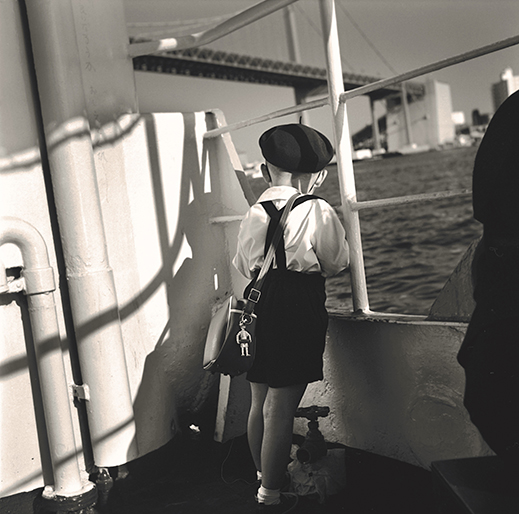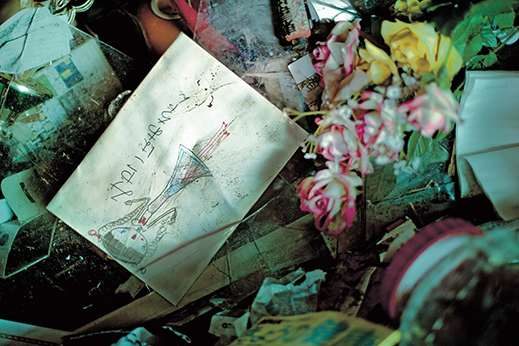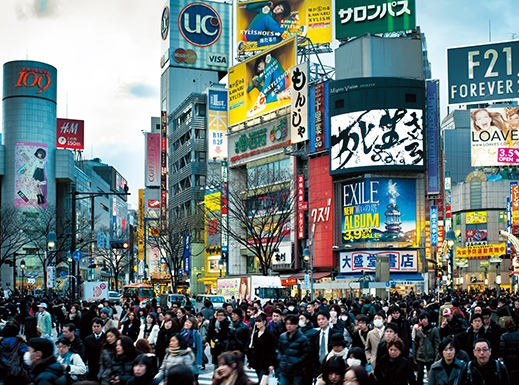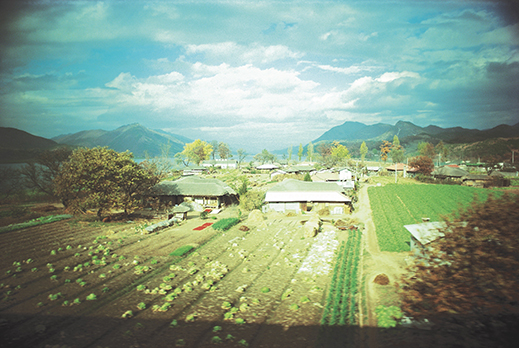Tibetan Plateau, 1975, © Shinya Fujiwara. "A person's time on earth is limited, like the finite life of cut flowers." |
When Shinya Fujiwara (b. 1944) quit art school and went vagabonding across Europe and central Asia, the result was Indo Horo (Wandering in India), a collection of photos that would have an extraordinary impact on his Japanese contemporaries. Its publication coincided with the demise of the fierce student movement of the sixties; it was a time when disaffected young activists were searching for a more personal raison d'etre, or simply wanted to get out of Japan. Many beat a path to India, which seemed to promise spiritual redemption or at least a radical change of scene.
India, 2010, © Shinya Fujiwara. "On the shores of the Ganges. An old man strikes a match to burn some incense for the dead. The palms of his hands that surround the fire, as if to protect it from the river winds, are beautiful like those of a sacred statue." |
Fujiwara's photographs of the subcontinent pulled no punches. Eschewing romantic visions of meditating swamis and ancient temples (cue the sitar music), he trained his lens on images of life in hard circumstances, and of death itself: bodies burning on pyres by the Ganges, corpses being consumed by wild dogs, aged sadhus who resembled living skeletons. Raw and real, these pictures spoke to a generation of youth already fed up with the superficialities of modern life in a developed country. Fujiwara followed up with other series in a similar vein -- Wandering in Tibet, Tokyo Drifting -- and confronted the subject of death head-on in Memento-Mori, a 1983 bestseller that propelled him to icon status, a position he retains today among contemporary photographers. Subsequent travels in the U.S. and Europe expanded his study of life's bitter beauty to locales ranging from desert towns in the American southwest to brothels in Istanbul.
Portrait of the artist, 2010, © Yuji Tozawa. |
|
 |
|
|
|
Moji Port, 1991, © Shinya Fujiwara. "I saw my own boyhood in the sight of a young boy who stood with his back to me on the ferry."
|
Fujiwara grew up knowing hardship. His parents ran an inn in the port city of Moji on the southern island of Kyushu, but their business failed when he was 16. Fujiwara had to leave his hometown and did not return for 30 years. At 18 he made his way to Tokyo, where he did various kinds of labor. Along the way he developed an affinity for painting, and his talents earned him a scholarship at age 22 to the elite Tokyo University of the Arts. After two years, however, he dropped out and began to travel, leaving brushes and easel behind in lieu of a camera. After his first trip to India the pictorial weekly Asahi Graph ran his Indo Horo photos in a 13-page feature that won Fujiwara instant fame. Since then he has made it his mission to scrutinize human mortality in all its permutations, whether in the Tohoku region amid the fresh devastation of the 2011 earthquake and tsunami, or the deserted streets of Tokyo during the first Covid lockdown of 2020.
 |
|
Miyako, 2011, © Shinya Fujiwara. "When I set foot in a house in the city of Miyako that had been destroyed by the tsunami, I found a child's drawing covered in sand among the scattered pieces of furniture on the floor. 'Grandma Miyako.' So it was written in a child's faltering handwriting. I hoped that they were alive. I pressed the shutter, and put my hands together in prayer." |
The Eyes of the Prayer, a Fujiwara retrospective now at the Setagaya Art Museum in Tokyo, purports to be the first "large-scale solo exhibition" by the photographer -- surprisingly so, since he is so well known. The show delivers as promised, with gallery after gallery packed with images from all of his major series. Accompanying them are lyrical but unsentimental texts by Fujiwara commenting on his subject matter. This is in keeping with the format of all of his books, in which he makes it a practice to gloss his pictures with words. The museum has kindly provided a List of Works that contains English translations (by Kei Benger) of these accompanying texts.
Mount Osore, 2016, © Shinya Fujiwara. "A thick morning fog lingered in the air. I turned around to see the white sun afloat in the sky. It looked like an eye, gazing upon me and all that existed in the world." |
Among the more recent additions to Fujiwara's oeuvre are two series that, juxtaposed as they are in this exhibition, offer some trenchant contrasts. One is a set of photos of young people protesting in Hong Kong during the Umbrella Movement of 2014, in hindsight a precursor of the protests this year and their ultimate suppression. Nearby, another wall carries photos of young people thronging the streets of Shibuya, Tokyo, in 2015 -- dressed as ghouls or anime characters in celebration of Hallowe'en.
 |
|
Shibuya, 2010, © Shinya Fujiwara. "Human life is prescribed with a time limit of 80 years. Life is short, and you only live once. Don't live a lifeless life. With the intention of communicating this wish, I wrote the words 'Don't Die, Live' in calligraphy, and screened it on the digital signage above the Shibuya scramble crossing. Soon after, a huge tsunami hit Eastern Japan, and this wish came to take on a different meaning. Ten years later, as we find ourselves living in a pandemic, the words 'Don't Die, Live' deliver a more urgent and compelling message." |
Fujiwara's photographic technique is as understated as his subjects are provocative. Neither a disciple of the sixties' avant-garde are bure boke school of blurry, grainy, high-contrast monochrome work, nor an aficionado of super-hi-res digital perfection, he favors shots that are almost gauzy in texture, on the verge of out-of-focus, yet which nonetheless stun the viewer with their poetic, often brutal imagery and vivid hues. (He almost always works with color film.) Perhaps the lack of glossy precision serves to prod the eye toward the subject at hand, rather than divert it with technical wizardry. The result is a compelling chronicle of a half-century of human joys and sorrows, wisdom and folly, life and death on this planet.
 |
|
Korean Peninsula, 1977, © Shinya Fujiwara. "On this side of the gently sloping mountains of the Korean Peninsula, I always come across mothers carrying their child on their backs. Such 'forms of love' -- this unity of mother and child -- stand at the foot of mountains, riverbeds, fields, markets, roadsides, and everywhere across the peninsula like statues of tutelary deities." |
|
 |
|
|
|
Bali Island, 2000, © Shinya Fujiwara. "In the mountains of Bali. I half immerse myself in an uninhabited swamp, waiting for the lotus flower to bloom in the dark of the morning. As the eastern sky begins to turn red with the sunrise, the lotus petals slowly start to unfold as if in response. I find myself breathtaken by the sheer beauty of this very moment in which the world begins."
|
This will be my last Here and There column. As announced on our front page, with this issue artscape Japan will cease publication in its present form. Aside from the abruptness of a decision that was out of my hands, I don't have too many regrets. It's been a good run for a corporate-owned online publication -- 16 years, since 2006. As editor of the site I have worked with some wonderful writers on our Focus reviews, and, for this column, with some very helpful and generous museum and gallery staff. Best of all, I have learned a lot about Japanese art and architecture! I am also tremendously grateful for the praise, encouragement, and valuable advice we have received over the years from you, our readers. I hope you will think of us on occasion and perhaps even refer back to past articles in our archive, accessible here. Thank you so much for your support all these years.
All images are courtesy of the Setagaya Art Museum. All quotations are by Shinya Fujiwara, translated by Kei Benger.
|
|
|
| |
 |
Alan Gleason
Alan Gleason is a translator, editor and writer based in Tokyo, where he has lived for over 30 years. Since 2006 he has edited artscape Japan and written the Here and There column, as well as translating the Picks reviews. He also edits and translates works on Japanese architecture, music, and theater. |
|
|
|
|